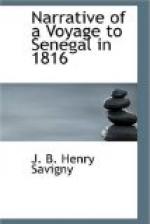There is not an atom of calcareous stone in the whole country: almost all the plants are twisted and thorny. The Monbins are the only species of timber that are met with. The thorny asparagus, A. retrofractus, is found in abundance in the woods; it tears the clothes, and the centaury of Egypt pricks the legs. The most troublesome insects of the neighbourhood are gnats, bugs, and ear-wigs. The monkey, called cynocephalus, plunders the harvests, the vultures attack the sick animals, the striped hyoena and the leopard prowl about the villages during the night; but the cattle are extremely beautiful, and the fish make the sea on this coast boil, and foam by their extraordinary numbers. The hare of the Cape and the gazell are frequently met with. The porcupines, in the moulting season, cast their quills in the fields, and dig themselves holes under the palm trees. The guinea-fowl (Pintada), the turtle-dove, the wood-pigeon are found every where. In winter immense flocks of plovers of various species, are seen on the edges of the marshes, and also great numbers of wild ducks. Other species frequent the reeds, and the surface of the water is covered with geese of different kinds, among which is that whose head bears a fleshy tubercle like that of the cassowary. The fishing nets are made of date leaves; their upper edge is furnished, instead of cork, with pieces of the light wood of the Asclepias.—The sails of the canoes are made of cotton.
Several shrubs, and a large number of herbaceous plants of this part of Africa, are found also in the Antilles. But among the indigenous plants, are the Cape Jessamine, the Amaryllis Rubannee, the Scarlet Hoemanthus, the Gloriosa Superba, and some extremely beautiful species of Nerions. A new species of Calabash, (Crescentia) with pinnated leaves is very common. Travellers appear to have confounded it with the Baobab, on account of the shape of its fruits, the thickness of its trunk, and the way in which its branches grow. Its wood, which is very heavy and of a fallow colour, has the grain and smell of ebony: its Yoloffe name is Bonda, the English have cut down and exported the greatest part of it.
In short, Africa, such as we have seen it either on the banks of the Senegal or the Peninsula of Cape Verd, is a new country, which promises to the naturalist an ample harvest of discoveries, and to the philosophical observer of mankind, a vast field for research and observation. May the detestable commerce in human flesh, which the Negroes abhor, and the Moors desire, cease to pollute these shores! It is the only means which the Europeans have left to become acquainted with the interior of this vast continent, and to make this great portion of the family of mankind, by which it is inhabited participate in the benefits of civilization.
[1] The Medusa was armed en flute, having only 14 guns on board; it was equipped at Rochefort with the Loire.




